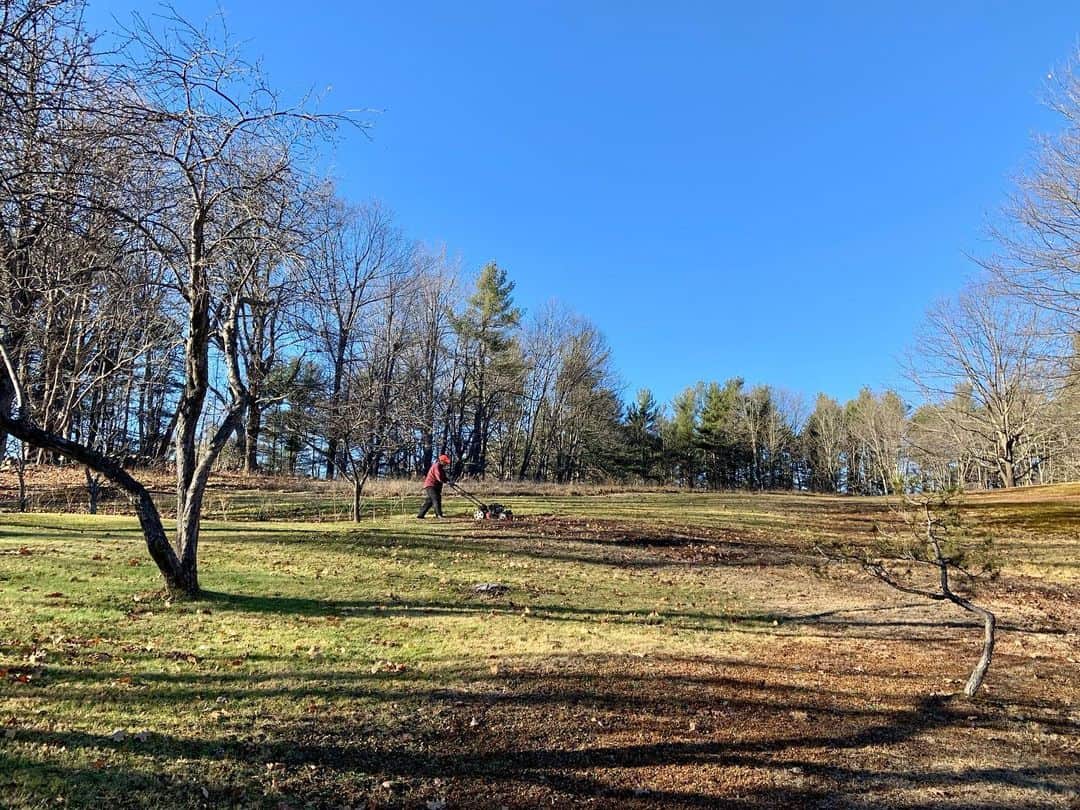Would you like to have a healthy, neat lawn all year round? If so, you’ll need to pay attention to your lawn even in the middle of winter. Just because it’s miserable outside, doesn’t necessarily mean your lawn has stopped growing.
You can mow the lawn in February, as long as you do it at the right time. There are a few things you need to keep in mind such as only mowing when the grass is dry and not cutting it too short. The type of grass will play a role in how you treat your lawn in winter.
Keep reading to find out more about mowing your lawn in February.

Image credit: @batemanterri
Is it ok to cut grass in February?
Is February too early to cut the grass? This might be the most pressing question on your mind, regardless of your need for tidiness. You might have heard how detrimental it can be. Fortunately, the answer is yes, you can cut your lawn in February as long as you follow a few simple rules.
Good lawn care in winter will result in a healthy, lush lawn when spring comes around. Winter care can also help to prevent issues such as pests and diseases. Let’s take a look at the proper lawn care for February, UK.
What’s the proper lawn care in February?
Caring for a lawn from January to March is a little different from lawn care in the summer months. The growth of the lawn will slow down as the first frost kills off many of the leaves. There are a few things you absolutely must do and a few things you must avoid at all costs. Let’s take a look:
Keep the lawn clean

Rake up those leaves. Image credit: @tales_from_a_cottage_garden
It’s extremely important to remove any debris from your lawn. Leaves, bark and other debris can damage your already struggling lawn even further. Winter lawns need all the sunlight they can get to stay healthy and thrive in spring.
Make sure to rake the lawn at least once a week to remove any debris that might have accumulated. This is extremely important, especially in autumn.
Stay off a frozen lawn

Avoid walking on a crunchy lawn. Image credit: @ogrodymaciejewski
If your lawn is frozen at night or early in the morning, avoid going onto the lawn. Crushing frozen grass underfoot damages the plant resulting in brown patches. Frozen grass blades are very fragile, make sure to stay off the lawn and stick to the paths during days with very cold temperatures.
Only mow when the grass is dry

The weather conditions need to be right for a winter mow. Image credit: @soyoocaltabiano
It can be very tricky to find a time when the weather allows you to cut the lawn. When you do get a gap between snow, rain and frost, make sure the grass is dry before you mow. Cutting wet grass can result in root damage. This will cause your lawn to look patchy once the grass starts growing again. Another reason to mow only when the lawn is dry is wilting, the water droplets will weigh down the blades of the grass, resulting in an uneven cut. Give your lawn the best chance to bounce back in spring by only cutting when the grass is dry.
Keep the grass as long as possible
It’s extremely important not to cut the grass too short when mowing in February. The length of the grass protects the roots from frost damage. The longer blades also help with photosynthesis in winter, resulting in a healthier, lush green lawn in spring.
You can trim the top to neaten up the lawn, but make sure to never cut more than a third of the grass blade length. This means if your lawn grass stands around 7.5cm (3inches) tall, you should only cut 2.5cm (1inch) off the top.
If you do cut the lawn, make sure to remove the clippings. Any debris on the lawn blocks out the already weak sunlight which will affect the health of your lawn. You can remove the clippings by raking them into a pile and adding them to your compost heap, or by using a lawn mower with a basket to capture the clippings before they even reach the lawn.
When to start cutting grass?
When you can start to cut your grass will depend on the type of grass you have. Warm season grasses will become dormant as soon as the first frost appears. These grasses will only need a trim once or twice during the winter months, if at all.
You can usually get away with not mowing until the first month of spring or until the temperature starts rising which will trigger your grasses to start growing. If your lawn looks untidy, however, don’t be afraid to get in there and neaten it up. Just make sure to keep the tips mentioned above in mind.
Cold season grasses on the other hand are quite hardy and will continue to grow slowly throughout winter. If you have cold-season grass, you will need to give your lawn a light trim every 3 to 4 weeks to keep it looking neat.
Conclusion
Now that you know a bit more about mowing your lawn in February, you can start planning to have the healthiest, greenest lawn on the block. Lawn care in winter is extremely important for a headstart in spring. Keep your lawn debris free, trim it when needed, make sure to stay off a frozen or wet lawn and only mow when the grass is dry.
If you follow these tips, your lawn will turn green and lush much faster. As soon as the growing season starts your lawn will bounce back quickly. The next thing you’ll need to look into is fertilising your lawn to kick start that growth. You can also overseed early in the spring to get that dense growth everyone talks about.
Happy lawn mowing!

Save this pin for later






